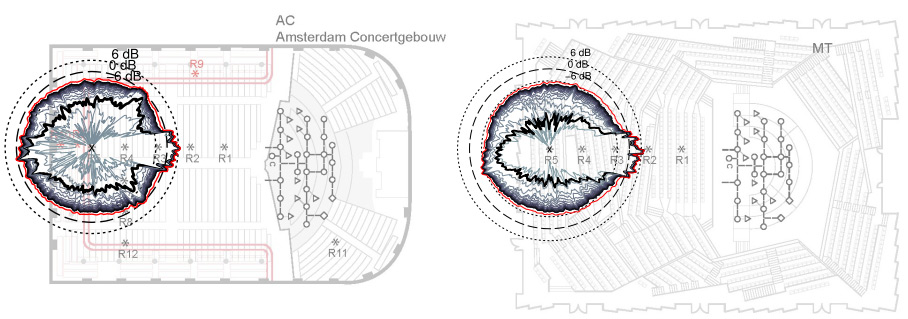- Details
- Published: 09 January 2013
The spatiotemporal visualization method display the cumulative development of the sound field as a function of direction by forward-integrating the energy in the impulse response in short time frames. The motivation for the approach is the presentation of spatial sound field of concert halls in format that a) enables quick comparison between halls, b) emphasizes subjectively important aspects, c) is fairly easy to learn and understand, and d) does not need interactive media. The method is published in the Journal of the Acoustical Society of America [1].
Objective room acoustics is an essential part of the evaluation of the acoustics of performance venues. The subjective quality of concert hall acoustics is traditionally formed around various descriptors, such as loudness, reverberance, clarity, definition, and envelopment in the sound field [1]. Well known standardized objective parameters, such as G (strength), T30 (reverberation time), EDT (reverberance), C80 (clarity), and LEF (lateral energy fraction) have been developed to quantify different subjective aspects in the acoustics. However, the general objective measures rely heavily on the statistical properties of the sound fields, thus, they are not suitable for accurately describing the acoustic details in rooms. Instead, they aspire to compress the acoustic information in a small set on numeric values.
Spatiotemporal analysis of room acoustics requires measuring of spatial room impulse responses. Earlier methods have mainly concentrated on visualizing sound intensity vectors, where as a potential downside the contribution of e.g. certain early reflections is obscured. The forward-integrating approach aims to overcome this deficiency. Particularly when used with a large number of source positions on stage, the effect of the hall geometry will be emphasized for features that are relevant for most of the source positions.
The current development stage of the method employs the Spatial Decomposition Method (SDM) [2] in the directional analysis. By applying SDM to a spatial impulse response, we obtain directional information for each sample in a monaural impulse response. From the combination of the monaural pressure and spatial metadata, it is then possible to calculate directional energy histogram over different time windows. The histograms are stacked in the visualization so that each of the cumulative time frames indicate where the sound energy is arriving to the receiver position around that time.
References
[1] J Pätynen, S Tervo and T Lokki: Analysis of concert hall acoustics via visualizations of time-frequency and spatio-temporal responses. Journal of the Acoustical Society of America 133(2):842-857, 2013. URL BibTeX / Info
@article{pat13jasa,
author = {J. P{\"a}tynen and S. Tervo and T. Lokki},
date-added = "2013-02-04 10:49:56 +0200",
date-modified = "2013-02-04 10:51:00 +0200",
journal = "Journal of the Acoustical Society of America",
number = 2,
pages = "842-857",
title = "Analysis of concert hall acoustics via visualizations of time-frequency and spatio-temporal responses",
url = "http://dx.doi.org/10.1121/1.4770260",
volume = 133,
year = 2013
}
[2] ISO 3382-1:2009. Acoustics - Measurement of room acoustic parameters -I: Performance spaces. International Standards Organization, 2009. BibTeX / Info
@book{iso33822009,
author = "{ISO 3382-1:2009}",
publisher = "International Standards Organization",
title = "Acoustics - {M}easurement of room acoustic parameters -{I: Performance spaces}",
year = 2009
}
[3] S Tervo, J Pätynen, A Kuusinen and T Lokki: Spatial decomposition method for room impulse responses. Journal of the Audio Engineering Society 61(1/2):16–27, 2013. URL BibTeX / Info
@article{ter13jaes,
author = {S. Tervo and J. P{\"a}tynen and A. Kuusinen and T. Lokki},
journal = "Journal of the Audio Engineering Society",
keywords = "Room acoustic analysis, Auralization",
month = "January/February",
number = "1/2",
pages = "16--27",
title = "Spatial decomposition method for room impulse responses",
url = "http://www.aes.org/e-lib/browse.cfm?elib=16664",
volume = 61,
year = 2013
}
[4] J Pätynen, S Tervo and T Lokki. A loudspeaker orchestra for concert hall studies. In The Seventh Int. Conference On Auditorium Acoustics. 2008, 45-52. BibTeX / Info
@inproceedings{pat08b,
address = "Oslo, Norway",
author = {J. P{\"a}tynen and S. Tervo and T. Lokki},
booktitle = "The Seventh Int. Conference On Auditorium Acoustics",
comment = {Online},
keywords = "Concert hall acoustics",
month = "Oct. 3-5",
note = "Also published in Acoustics Bulletin 2009, 34(6), pp. 32-37.",
organization = "Institute of Acoustics",
pages = "45-52",
title = "A loudspeaker orchestra for concert hall studies",
year = 2008
}
[5] J Pätynen. A virtual loudspeaker orchestra for studies on concert hall acoustics. PhD Dissertation, Aalto University School of Science, Espoo, Finland, 2011. BibTeX / Info
@phdthesis{patynen_diss,
address = "Espoo, Finland",
author = {J. P{\"a}tynen},
school = "Aalto University School of Science",
title = "A virtual loudspeaker orchestra for studies on concert hall acoustics",
type = "{PhD} Dissertation",
year = 2011
}




